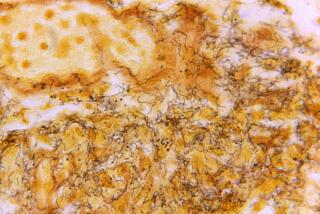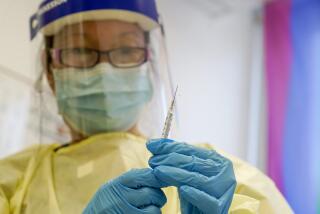New AIDS Cases Show Decline in U.S.
- Share via
WASHINGTON — For the first time since the AIDS epidemic was identified 16 years ago, the number of newly diagnosed cases of the disease in adolescent and adult Americans declined last year, federal health officials reported on Thursday.
The incidence of the disease in people older than 12 fell 6% from 1995 to 1996, from 60,620 cases to 56,730 cases, the federal Centers for Disease Control and Prevention said.
The encouraging trend--going hand-in-hand with reports in recent months of dramatic drops in AIDS-related deaths--likely reflects the impact of powerful new drug treatments and prevention efforts that have prolonged symptom-free survival for those with the virus, health officials said.
The new CDC numbers represent individuals who developed clinically defined AIDS--that is, who experienced an AIDS-related infection or other symptom, or whose immune system CD4 cells have dropped to 250 or lower, or both.
The figures do not represent a trend in the number of new infections; an individual can be infected with AIDS for years before developing symptoms.
Nor was all the news positive. The incidence of cases traced to heterosexual transmission continued to rise, jumping 11% among men and 7% among women.
Still, health officials hailed the overall decline. “This is remarkable evidence that our efforts in prevention and treatment are allowing more people to live free of HIV while we are extending the healthy lives of those who are infected,” Health and Human Services Secretary Donna Shalala said.
Dr. David Satcher, the CDC director and President Clinton’s nominee for surgeon general/assistant secretary for health, called the new numbers an indication of progress on the AIDS front. But he added that working “to prevent new infections in the first place” should remain the first priority.
The CDC report found that:
* Among gay and bisexual men, newly diagnosed AIDS cases dropped 15% for whites, 8% for Latinos and 3% for blacks.
* Among all whites--men and women--the decline was 13%, while cases among all Latinos fell 5%. Among all African Americans, no change occurred in the incidence of cases between 1995-96.
* By region of the country, AIDS incidence declined 12% in the West, 10% in the Midwest, 8% in the Northeast and 1% in the South.
* Among the new cases traced to heterosexual transmission, the greatest proportionate increases occurred among African American men (19%), Latino men (13%), and African American women (12%).
Dr. Helene Gayle, a CDC official, said the changing trends in AIDS transmission demonstrated by the figures would likely alter the way the federal government tracks the epidemic. “We must improve our ability to monitor HIV infection to effectively determine evolving patterns . . . so that we can appropriately target resources for prevention and treatment,” she said.
The CDC also reported that the number of people in the United States living with AIDS increased 11% between 1995 and 1996, an indicator that individuals with the disease are surviving longer. As of December 1996, Americans living with AIDS totaled 235,470.
While this is generally regarded as positive news, it also means “there will be more people to take care of,” one CDC official said.
Despite the recent flood of decidedly upbeat news concerning the disease, AIDS experts and activists repeatedly have cautioned that the benefits of the new drug therapies could be short-lived and that no one should assume the crisis has ended. But many scientists believe that understanding gained during this period could lead to even better treatments.
More to Read
Sign up for Essential California
The most important California stories and recommendations in your inbox every morning.
You may occasionally receive promotional content from the Los Angeles Times.










